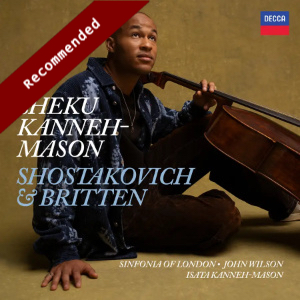
Dmitri Shostakovich (1906-1975)
Cello Concerto No.2 in G, op.126
Benjamin Britten (1913-1976)
Cello Sonata, op.65
Dmitri Shostakovich
Cello Sonata in D minor, op.40
Sheku Kanneh-Mason (cello)
Isata Kanneh-Mason (piano)
Sinfonia of London/John Wilson
rec. 2024, St. Augustine’s Kilburn, London (concerto); Snape Maltings Concert Hall, UK (sonatas)
Decca 4870835 [80]
Here is a question for you: how many prominent British performers under forty can you name who were largely educated in state schools? The answer is not many! And that is just one of the utterly remarkable things about cellist Sheku Kanneh-Mason. He went to a local comprehensive school in Nottingham. It had at that time a vibrant and highly active music department, which he participated in and benefited from enormously.
Not very long ago, Sheku returned to the school, and found that it was all gone – the choirs, the orchestras, the vibrant musical life. No-one who has been following what has happened to the British musical education scene over the past few years will be the least bit surprised, but it is tragic and worrying.
End of mini-rant; but it does matter, for lots of different yet related reasons. Suffice it to say that Sheku and his family are a rarity: something in contemporary British culture to be proud of and excited about. This programme is simply another confirmation: three 20th century masterpieces for the cello, very different. Dmitri Shostakovich’s pieces – Cello Concerto No.2 and the Cello Sonata – come from the opposite ends of his career. Benjamin Britten wrote his Cello Sonata when he was at the height of his fame and maturity.
There is another presence at this recording. Mstislav Rostropovich, the great cellist, was the dedicatee of Britten’s sonata and Shostakovich’s concerto. In the accompanying booklet, Kanneh-Mason explains how moving it was to record the former at the Snape Maltings. Rostropovich premiered the work there in 1961, with the composer at the piano.
The second cello concerto is one of Shostakovich’s greatest and most remarkable works. He wrote it when he was at a sanatorium in the Crimea, treated for the heart condition that blighted the later stages of his life. It is a puzzling work, with undertones of bitterness and despair. It has taken it some time to rival the popularity of the first cello concerto. But it is now recognised as a masterpiece, and often cited as the first work in Shostakovich’s late style.
Kanneh-Mason has taken it to heart; as he admits in the booklet notes, he has loved and studied it for a long time. He characterises every part of it powerfully, and he has ideal collaborators in the Sinfonia of London and John Wilson. There are many memorable interactions between soloist and orchestra. Take the squabbling bassoons in the middle movement, and the whooping horns that introduce the third movement. And, most of all, there is the terrifying outburst in the finale: the unassuming Ukrainian folk-song from the scherzo, Bubliki, kupite bubliki (Bagels, buy my bagels), is screamed out by the full orchestra, with vicious whip-cracks.
On the face of it, Britten’s sonata from 1961 is a much lighter affair. Indeed, it has something of the nature of a suite, with its sequence of quite short movements. It is clear, however, that Rostropovich’s unsurpassed virtuosity set Britten’s imagination on fire. The whole thing is alive with thrilling creativity. It was Shostakovich who introduced Britten to Rostropovich. As a subtle tribute, in the final movement Britten uses the D-S-C-H motif (D-E♭-C-B in the English notation). It was Shostakovich’s ‘signature’ in many of his compositions.
Once more, Sheku Kanneh-Mason’s capacity for characterising the music comes through strongly. He is joined by his equally talented older sister Isata, who makes a fine job of the piano part – cannot call it an ‘accompaniment’! Needless to say, their partnership is a thing of beauty in itself.
Isata is the pianist again in Shostakovich’s Cello Sonata of 1934, written for the composer’s close friend Viktor Kubatsky. After the premiere in Moscow, the two went on a tour. One morning, in the far-north town of Arkhangelsk, Shostakovich picked up a copy of Pravda, and read the article ‘Muddle Instead of Music’, a brutal demolition of his opera Lady Macbeth of Mtsensk. Though uncredited, the article was certainly by Stalin himself; Shostakovich’s career, and indeed his very survival, were now endangered. His life would never be the same.
The work begins with a long, fully developed movement laid out in sonata form. The sweet lyricism of much of it makes it remarkable to think that Shostakovich wrote it shortly before that self-destructive behemoth, the 4th Symphony. The wild second movement sounds at times like a sketch for the Sabre Dance! There follows a deeply expressive Largo. The short finale is based on one of Shostakovich’s wry march tunes. The Kanneh-Masons rise magnificently to the huge technical and emotional demands of this music.
In a couple months, it will be fifty years since the death of Dmitri Shostakovich, one of the towering figures of 20th century music. This disc is a wonderful symbol of his continuing significance for new generations.
Gwyn Parry-Jones
Buying this recording via a link below generates revenue for MWI, which helps the site remain free



















